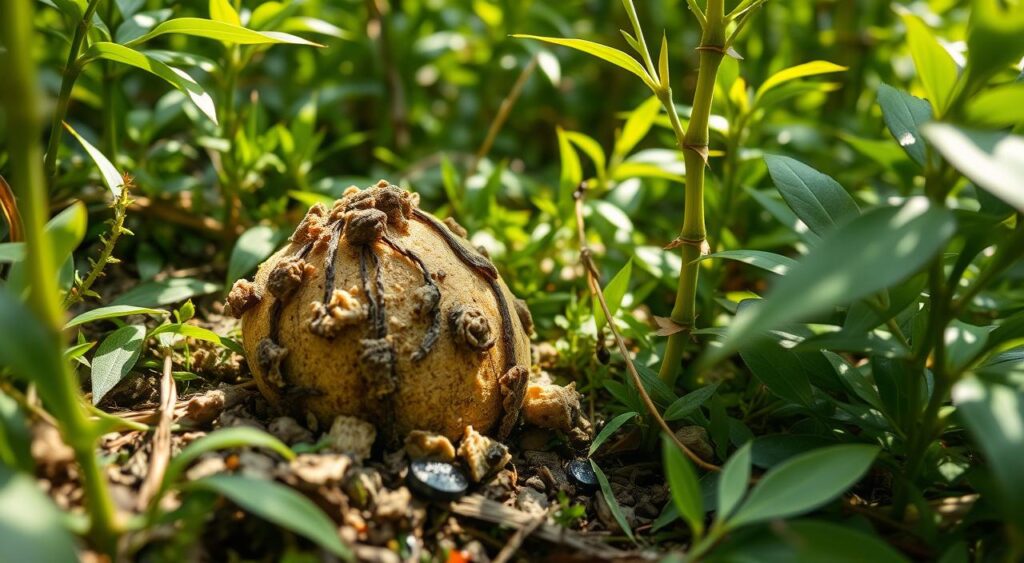Panda Behavioral Studies: For years, people thought giant pandas (Ailuropoda melanoleuca) lived alone, eating bamboo in China’s Sichuan Province. But new studies show they have a more interesting social life. Researchers are using new methods to learn about their social habits and how they talk to each other.
Key Takeaways
- Giant pandas show more social behavior than we thought, like playing, scent-marking, and making friends.
- Mothers spend a lot of time with their cubs, especially the male ones.
- Pandas use scent-marking trees like a social media to share updates and find mates.
- By studying panda scat and social networks, researchers have uncovered their complex social lives.
- Learning about panda social behavior helps us understand conservation and human social habits too.
Unveiling the Secret Social Life of Giant Pandas
Many think giant pandas live alone, but new research shows they have a complex social life. They use “scent-marking trees” like social media. These trees help pandas share their identity, sex, size, and if they’re ready to mate.
By studying panda poop DNA in China’s Wolong Nature Reserve, scientists learned about their social bonds. They found pandas mostly hang out with family outside of mating season. But, they use scent-marking trees to find mates and avoid inbreeding during mating season.
Scent-Marking Trees: A Panda Version of Social Media
A study of 23 wild pandas over two years showed they are more social than we thought. They were often found together, and some pandas even formed family groups. This suggests a deep understanding of their social network.
The researchers also found pandas return to their favorite spots after months away. This shows they know their social and territorial boundaries well. Their “social media” helps them stay connected even when apart.
With only 1,864 wild pandas left, knowing their social habits is key to saving them. By improving their social lives, scientists aim to boost their chances of survival. This could help protect these amazing animals for generations to come.
The Power of Panda Poop: Unraveling Social Networks

Studying giant pandas reveals a surprising truth about their social lives. Their poop is key to understanding their connections. Pandas are not as solitary as we thought.
Researchers found DNA in panda poop that helped identify individuals. They mapped out their social connections using this genetic data. They also looked at scent-marking behaviors to get a full picture of their social network.
By using “clique detection” techniques, similar to those for human social networks, they found pandas have complex social structures. They discovered pandas form groups based on who they hang out with and their family ties.
“Panda poop is the gold standard of panda watching,” said lead researcher Dr. David Hu. “It provides a reliable trail of information that allows us to peer into the secret social lives of these fascinating animals.”
This study sheds light on panda social networks, proximity, and association. It shows how important understanding their social behavior is for conservation. By knowing how pandas interact, scientists can create better plans to protect them.
This research is crucial for the panda population, which faces many threats. By using DNA and new analysis methods, scientists are learning about panda social dynamics. This knowledge will help in protecting these iconic animals.
Panda Behavioral Studies: A Window into Their Social Dynamics

This study on panda social network analysis sheds light on their habitat use and social interactions. It shows how pandas use scent-marking trees and the importance of family and mating. This knowledge helps in making better conservation policies to protect pandas and their ecosystem.
Panda social behavior is complex and interesting. It shows the web of relationships and interactions within their species. By studying the coupled human-natural systems pandas live in, researchers understand their social lives better. This helps in knowing how these factors affect their survival.
The research team found key insights into pandas’ environment use and social cues. For instance, scent-marking trees act like “social media” for pandas. They help individuals communicate and mark their territories within the habitat use patterns of the species.
| Behavior | Frequency | Significance |
|---|---|---|
| Scent-marking trees | High | Establishes individual territory and communication |
| Family/mating relationships | Moderate | Shapes social dynamics and reproductive success |
| Habitat utilization | Varies seasonally | Adapts to resources and environmental factors |
By exploring the social network analysis of pandas, researchers gain insights into their relationships. This knowledge helps in creating conservation policies and management strategies. It ensures the long-term survival and well-being of these amazing animals.
“Understanding panda behavior is crucial for developing effective conservation strategies that address the unique needs and challenges faced by this endangered species.”
The Importance of Understanding Panda Behavior

Studying panda behavior is key to saving them. Pandas live in areas where humans and nature meet. Knowing how they act, where they live, and what they need helps us protect them. This knowledge helps us make plans to keep pandas safe and their homes healthy.
By studying how pandas use their space, talk to each other, and find food, we can help them thrive. This way, we can make sure pandas keep living in the wild for a long time.
Conservation Implications and Coupled Human-Natural Systems
Studies on pandas show how they and humans are connected. For example, breeding pandas in captivity is hard. Up to 80% of female pandas in captivity don’t breed like they should. This shows how important it is to know about panda biology and behavior for conservation.
Research also tells us that panda cubs stay with their moms longer than we thought. This helps us make better plans for pandas in captivity and in the wild. By following their natural ways, we can do better for pandas and their homes.
| Key Insights from Panda Behavioral Studies | Implications for Conservation |
|---|---|
| Up to 80% of captive female pandas failed to display normal breeding behavior | Underscores the need to understand panda biology and behavior to improve captive breeding success |
| Wild panda cubs stay with their mothers for 1.5 to 2.5 years, but captive cubs are often separated before 6 months | Suggests the need to align captive management practices with natural cub-rearing behaviors |
| Pandas rely more on spatial memory and may face challenges adapting to environmental changes | Highlights the importance of preserving panda habitats and maintaining connectivity between fragmented ecosystems |
Learning about pandas’ social lives, homes, and how they adapt helps us save them. This knowledge is vital for making good plans to protect pandas and their homes. It helps us work together with nature and humans to keep pandas safe.
Stereotypic Behavior and Environmental Factors

Researchers have explored the world of stereotypic behaviors in giant pandas. They looked at how different environmental factors affect these behaviors. In zoos, pandas often pace or head-bob without a clear reason. These actions, known as stereotypies, are studied to find out why they happen.
A study in 2001 showed that enriching the environment of giant pandas helped. The results were positive, with scores ranging from 447 to 457. Another study looked at factors affecting stereotypies in giraffes and okapis, finding scores between 235 and 247.
The environment and how pandas are fed also play a role in their behavior. A study on captive big cats found that scores ranged from 71 to 83. A 2006 study found that pandas react to noise, like construction, affecting their cortisol levels.
Sub-adult pandas behave differently in different environments, a 2004 study showed. This suggests that their surroundings greatly influence their actions.
| Environmental Factor | Effect on Stereotypic Behavior |
|---|---|
| Low environmental temperature | Increase in stereotypic behavior in captive Asian elephants |
| High environmental temperature | Reduced duration of pacing behavior but increased frequency of pacing and the duration/frequency of door-directed behavior and head-toss |
| Humidity | No noticeable effect on most stereotypic behaviors, except for the frequency of head-toss |
| Sound intensity | No correlation with stereotypic behaviors |
| Visitor growth | Negatively associated with the duration of door-directed behavior |
| Outdoor vs. indoor enclosures | Significant difference in the duration and frequency of head-toss, pacing, and door-directed behaviors |
Studying the link between stereotypic behavior and the environment in giant pandas is crucial. It helps us understand their well-being and improve how we care for them in zoos.
Future Directions: Exploring Panda Behavior in the Wild

Our understanding of giant pandas is growing, and we’re now focusing on studying them in their natural homes. Captive research has given us insights, but observing wild giant pandas in their behavior in the wild is key. This is where we can truly see their social dynamics and how they adapt to their environment.
It’s important to keep watching and learning about wild giant pandas in their habitat. This helps us make better conservation programs and reintroduction plans. We want to know more about their social lives, how they find food, and what they like in their homes. This knowledge will help us protect and grow their numbers.
New tracking tools, like GPS collars on wild giant pandas, have given us amazing new insights. These tools show us how they move, what they do at different times of the year, and how their environment affects them.
“Understanding the behavior in the wild of giant pandas is essential for the long-term conservation of this iconic species. By exploring their social dynamics and habitat preferences in their natural environment, we can devise more effective conservation programs and reintroduction strategies to safeguard the future of the wild giant pandas.”
As we keep learning about pandas, we’re on the verge of even more exciting discoveries. By studying wild giant pandas more closely, we can find the best ways to help them survive and thrive in their habitat.
The future is full of challenges and chances for scientists, conservationists, and leaders to work together. We can all help protect and restore these amazing animals. Together, we can make sure wild giant pandas keep living in their habitat, showing us the strength of nature and life. captive giant pandas may animal behaviour may university press.
Also Read: Why Panda Conservation Matters: What Every Traveler Should Know
Conclusion
The panda behavioral studies have shown us how complex pandas are, unlike what we thought. They use social network analysis and DNA sampling to learn about pandas. This helps us see how they talk, make friends, and move around.
This new knowledge is key for conservation efforts. Knowing how pandas live and where they go helps us protect them. It also helps us keep their homes safe. This is crucial for the giant panda’s survival.
Studies on panda behavioral studies have shown us how amazing pandas are. They show us the importance of protecting their habitat. With this knowledge, we can make better plans to save the giant panda and their homes.

